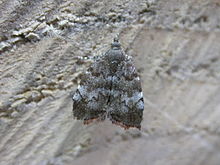- Choreutis pariana
-
Choreutis pariana 
Scientific classification Kingdom: Animalia Phylum: Arthropoda Class: Insecta Order: Lepidoptera Family: Choreutidae Genus: Choreutis Species: C. pariana Binomial name Choreutis pariana
(Clerck, 1759)Synonyms - Phalaena pariana Clerck, 1759
- Anthophila lutosa Haworth, 1811
- Asopia parialis Treitschke, 1829
- Pyralis pariana
- Hemerophila pariana
- Tortrix pariana
- Simaethis paralis
- Xylopoda parialis
- Eretromula pariana
- Simaethis pariana
The Apple-and-thorn Skeletonizer or Apple Leaf Skeletonizer (Choreutis pariana) is a moth of the Choreutidae family. It is native to Eurasia. It was introduced to New England in 1917 and is frequently collected in agricultural areas in North America where it is found along the west coast of the United States and British Columbia, Ontario, New Brunswick, Nova Scotia, Prince Edward Island and Newfoundland and Labrador.
The wingspan is 11-15 mm.[1] The forewings are pale smeared brown, with a coppery sheen. The inner half and terminal area are usually darker brown. The antemedial line is dark brown and jagged and usually only distinctive in the upper two thirds. The postmedial line is less obvious, paler brown, jagged and usually only upper two thirds are obvious. Occasionally, the other lines are visible, but never as obvious as the antemedial line. There are four small whitish rectangles visible along the costa at the antemedial line, median, postmedial line. The fringe is brown with two thin pale patches along the outer edge on either side of the middle. The hindwings are warm brown, but slightly darker towards the outer margin. The fringe is brown, but paler at the anal angle and apex. The body is dark brown.[2]
In Canada, adults have been recorded from late July to late October. There are two generations per year in western Europe, with adults on wing in July and again in September, when it overwinters and may appear again in early spring
The larvae feed on Malus pumila, Crataegus, Betula papyrifera, Salix, Prunus, Sorbus, Fraxinus, Rosa and Alnus species. It is a solitary leafroller and colonial feeder. The larvae eat away the parenchyma from the upper surface of leaves of the foodplant, resulting in a skeleton leaf appearance. The larva lives under a silken web. Larvae have been recorded from June to early September in North America.
References
External links
This article on a moth of the Choreutidae family is a stub. You can help Wikipedia by expanding it.
